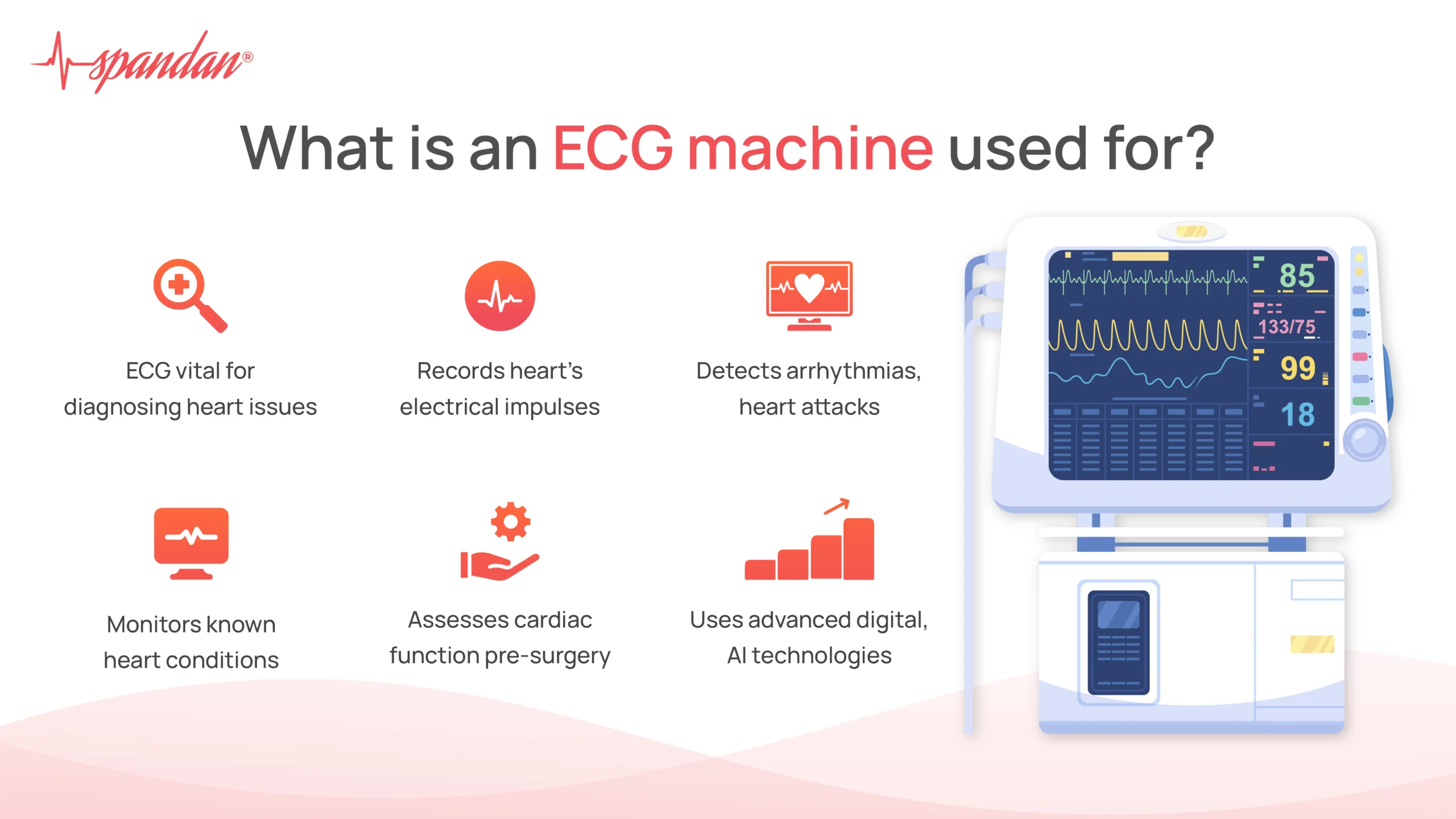
Author:- Mr. Ritesh Sharma
An ECG machine is an extremely vital tool when it comes to cardiac care. Whenever a patient experiences any heart-related issues, the first test healthcare professionals put them through is an electrocardiogram. This only underscores the importance of an ECG machine in diagnosing patients. Whether the patient had the complaint of a heart problem the first time, or he/she is a chronic patient, the healthcare professionals suggest ECG as the first diagnostic test. Therefore, you cannot overstate the importance of an ECG machine.
You must also note that there is hardly any more competent device than an ECG machine to detect heart abnormalities. All heart abnormalities ranging from fleeting heart palpitations to cardiac arrhythmias to something as life-threatening as a heart attack are diagnosed by an electrocardiogram machine.
The uses of an ECG machine are vast and cannot be summed up easily. Hence, we have crafted this blog. This blog will cover all the uses of an ECG machine by dissecting its components and applications. So, all clinicians who are learning about the usage of an ECG machine will find worthy information in this blog.
The Basics of an ECG Machine
An ECG machine records the electrical impulses generated by the heart as it beats. These impulses are captured via electrodes placed on the patient’s skin, typically on the chest, arms, and legs. The recorded data is displayed as waveforms on a monitor or printed on paper, allowing healthcare professionals to analyze the heart’s rhythm and electrical activity.
The ECG waveform consists of several key components:
- P wave: Represents atrial depolarization, the initial impulse triggering atrial contraction.
- QRS complex: Represents ventricular depolarization, the main impulse leading to ventricular contraction.
- T wave: Represents ventricular repolarization, the process of the ventricles resetting electrically before the next contraction.
Diagnostic Uses of an ECG Machine
- Detecting Arrhythmias: One of the primary uses of an ECG machine is identifying arrhythmias of different arrhythmia classifications, which are irregular heartbeats. Arrhythmias can be benign or life-threatening, such as atrial fibrillation, atrial flutter, ventricular tachycardia, monomorphic ventricular tachycardia, monomorphic atrial tachycardia and ventricular fibrillation. By analyzing the abnormal ECG, doctors can determine the type and severity of the arrhythmia and decide on appropriate treatments, which may include medication, lifestyle changes, or surgical interventions like pacemaker insertion.
- Diagnosing Heart Attacks: An ECG is crucial in diagnosing myocardial infarction (heart attack). During a heart attack, the blood supply to a part of the heart muscle is blocked, causing changes in the ECG waveform, particularly in the ST segment and T wave. Immediate interpretation of these changes allows for quick initiation of life-saving treatments, such as thrombolytic therapy or percutaneous coronary intervention (PCI).
- Monitoring Heart Conditions: Patients with known heart conditions, such as coronary artery disease, heart failure, or cardiomyopathy, are often monitored using ECGs. Regular ECGs help track disease progression, evaluate the effectiveness of treatments, and detect any new complications early.
- Assessing Cardiac Function Before Surgery: Before undergoing major surgery, patients often have an ECG to assess cardiac function. This preoperative evaluation helps identify any underlying heart issues that could complicate surgery or anesthesia, enabling the medical team to take necessary precautions.
- Evaluating Symptoms: An ECG is a go-to diagnostic tool when patients present with symptoms like chest pain, shortness of breath, dizziness, or palpitations. These symptoms can be indicative of various heart conditions, and an ECG provides valuable information to guide further diagnostic testing and treatment.
Predictive and Preventive Uses of ECG
- Screening for Heart Disease: ECGs are used in routine health check-ups and screening programs to detect early signs of heart disease, even in asymptomatic individuals. Early detection of abnormalities can lead to preventive measures, reducing the risk of serious cardiovascular events.
- Monitoring High-Risk Patients: Individuals with risk factors such as hypertension, diabetes, high cholesterol, and a family history of heart disease often undergo regular ECGs. Continuous monitoring helps in timely intervention and management, potentially preventing heart attacks and strokes.
Research and Technological Advancements
The ECG machine has seen significant advancements since its invention in the early 20th century. Modern ECG machines are more accurate, portable, and user-friendly. Technological innovations include:
- Digital ECGs: Digital technology has enhanced the accuracy of ECG readings and simplified the storage and sharing of data. Digital ECGs can integrate with electronic health records (EHR), allowing seamless access to patient data for healthcare providers.
- Wireless and Mobile ECGs: Portable ECG devices such as Spandan® ECG and mobile apps have revolutionized cardiac care by enabling continuous monitoring outside the clinical setting. Patients can wear these devices during daily activities, providing real-time data to their healthcare providers.
- Artificial Intelligence (AI): AI algorithms are being integrated into ECG machines to assist in the interpretation of complex waveforms. AI can help detect subtle changes that may be missed by the human eye, improving diagnostic accuracy and outcomes.
In conclusion, the ECG machine is an indispensable tool in modern medicine, crucial for diagnosing, monitoring, and predicting heart conditions. Its non-invasive nature, combined with its ability to provide immediate and detailed information about the heart’s electrical activity, makes it invaluable in both emergency and routine clinical settings. As technology continues to advance, the capabilities of ECG machines are expanding, further enhancing their role in improving cardiovascular health and saving lives.
From detecting arrhythmias and diagnosing heart attacks to monitoring chronic heart conditions and evaluating patients before surgery, the ECG machine is central to cardiac care. Its ability to provide rapid, accurate, and comprehensive information about heart health underscores its significance in medical practice. As research and technology progress, the ECG machine will continue to evolve, offering even greater insights into the heart and enabling more effective and personalized treatment strategies.



